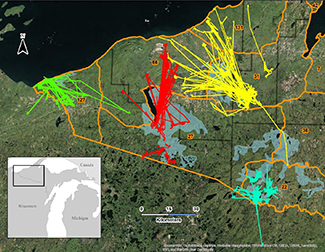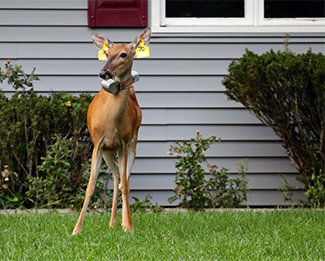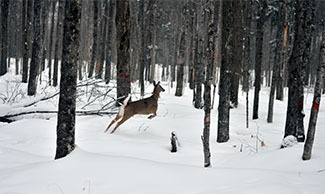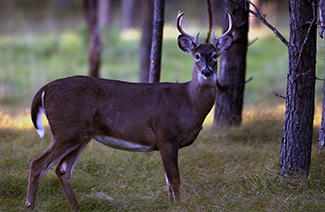Deer movement studies provide insight into CWD spread, management
By EMMA KUKUK
Michigan Department of Natural Resources

Since wildlife researchers first detected chronic wasting disease in Colorado in the 1960s, it has emerged as a growing concern for the nation’s wildlife agencies and hunters.
The disease is a fatal nervous system malady found in animals from the Cervidae family, which includes deer, moose and elk. It attacks the brain of infected animals, creating small lesions. There is no cure for CWD – it is 100% fatal in all animals that contract it.
Though the disorder affects several species, its impact on deer is of special concern. In states where CWD is established, it diminishes the health of deer and causes long-term population decline.
In Michigan, this disease challenges not only the foundation of wildlife conservation, but the state’s long-standing hunting traditions.
Wildlife agencies investigating CWD have found that deer movement is key to disease spread. Understanding deer movement is therefore vital to making the most of CWD management strategies.
Deer movement and abundance can influence several factors contributing to CWD’s spread, such as the probability of the disease occurring, contact rates, transmission rates and the geographic extent of an outbreak.
|

To better understand how this disease may be disseminated by deer, the Michigan Department of Natural Resources has been conducting deer movement studies in CWD-affected areas in the state’s Upper and Lower peninsulas.
These studies are critical for the development of management efforts to help curb the effects of the disease.
CWD in the Lower Peninsula
In 2015, when the state’s first CWD-positive free-ranging deer was found in mid-Michigan’s Ingham County, the DNR implemented a surveillance and response plan it had developed in 2002 (and updated in 2012) in anticipation of the disease being detected.
The response team conducted a survey of deer abundance in the area where the CWD-positive deer was found, identified the physical range of a core CWD area and CWD management zone, and collaborated with Michigan State University to design a study to track the movements and survival rates of deer in south-central Michigan.
The Lower Peninsula deer management study, conducted by the Boone and Crockett Quantitative Wildlife Center at MSU, and funded by the DNR and other partners, is based on some unique geographical components of the initial detection of CWD in Michigan.
Though there have been more than 120 confirmed cases of the disease in free-ranging deer in Michigan since the disease was first found here, the initial nine cases discovered occurred within a relatively concentrated area in the central part of the state.
|

The initial detection of the disease in Michigan also was unique in that, when it was found in Meridian Township, a Lansing suburb, it marked the first time a state had identified the initial cases of the disease from a more suburban environment, rather than a rural area.
Along with responding to CWD in an area of greater human development comes the increased need to understand how deer movements in these areas differ from rural areas, and how human development influences deer behavior, space use and selected habitat.
These factors influence how disease may spread across the landscape. Understanding how deer behavior differs between urban and rural areas is important for developing informed CWD management strategies.
The study area covers a diverse swath of terrain – from suburban neighborhoods to extensive agricultural land.
Jonathan Trudeau, a doctoral student in fisheries and wildlife at MSU, is on the research team heading up the study in the Lower Peninsula. He explained that, because Michigan’s landscape is varied, deer in the southern half of the Lower Peninsula likely don’t behave in the same manner as deer in the western and central Upper Peninsula.
“We’re collecting data on deer across this developmental gradient, which really hasn’t been done before,” Trudeau said. “The factors that influence the spread of the disease are likely very different than those in the U.P.”
The MSU research team is looking particularly at how far and how frequently deer in these suburban environments disperse – meaning that they permanently move from one area to another – and whether certain habitat structures or landscape features facilitate or hinder those types of movements.
|

Long-distance movements have the potential to drastically impact the spread of CWD across a broad landscape, but researchers aren’t just looking at long-distance or long-term movements.
Short-term movements, called excursions, also can influence the potential spread of CWD. These excursions are temporary movements outside of the deer’s typical range.
“We’ve had some deer go 18 miles there and back within a nine-day period, with pretty much every (sex and age) demographic of the population making these excursions,” Trudeau said.
While excursions like these seem relatively harmless, deer may be exposed to chronic wasting disease during these short trips by encountering infected deer or contaminated environments. CWD-positive deer also may make these excursions and expose other deer to the disease.
“One really nice thing about the project is that we’re looking at CWD and disease spread in this multifaceted manner,” said Trudeau. “We’re not only looking at how deer move and interact with their environment, but also how different management strategies impact the spread of disease and how to predict where it may ‘spark up.’”
Identifying the portion of the deer population most likely to make long-distance movements helps wildlife managers determine where best to focus management efforts. These data give important insight into how deer move in and around human development and how that activity affects CWD transmission.
Deer movement in the Upper Peninsula
Since May 2015, when the first CWD-positive deer was identified in the Lower Peninsula, the DNR has been surveilling the Michigan-Wisconsin border for signs of CWD in free-ranging white-tailed deer.
|

In 2018, the DNR confirmed the first CWD-positive deer in the Upper Peninsula, in Dickinson County.
Wildlife managers responded quickly, planning a study to learn how deer movements in the U.P. affect the risk of CWD transmission, and how those movements differ from deer studied in the Lower Peninsula.
The U.P. deer movement study, a partnership between the Camp Fire Program in Wildlife Conservation at the State University of New York’s College of Environmental Science and Forestry, and the DNR, has three objectives:
- Determine the frequency, distance and timing of deer movements, particularly between summer and winter range.
- Estimate population abundance.
- Develop models of probable deer movements for each population studied.
To meet these objectives, researchers capture deer and fit them with GPS collars to track their movements.
Capture and collaring efforts were concentrated on four deer wintering complexes – areas commonly referred to as “deer yards” that provide food and cover for deer in winter conditions – in the western U.P.
Another study area was added in southern Dickinson County after the discovery of CWD there in October 2018. Four of these deer wintering complexes are located along the Michigan-Wisconsin border. Wisconsin is also home to CWD-infected deer, some which have been detected in neighboring border counties.
“Information on these movements helps us make decisions on identifying CWD management zones,” said Dean Beyer, DNR wildlife research biologist. “This is particularly important in the Upper Peninsula, where the combination of high deer densities in the wintering complexes and long-distance migrations to summer range increases the risk of CWD transmission across very large areas.”
From the 190 deer collared in 2018, and the 97 collared in 2019, the researchers were able to track and observe the movement of deer from these areas.
Based on preliminary data, researchers observed spring migratory movements of up to 48 miles – demonstrating that deer move from these deer wintering complexes across vast areas. Researchers also observed some mixing of deer from different wintering complexes on their summer range.
“Together, these observations suggest that there would be a risk of transmitting CWD across very large areas because of the migratory movements,” said Beyer.
Not only do these data support a comprehensive approach to disease management, they also help the DNR plan its overall deer management program in the Upper Peninsula.
Moving forward
While there is no cure for chronic wasting disease, wildlife managers remain committed to better managing its spread.
“Disease management means understanding the species affected. That includes their movement patterns,” said Chad Stewart, DNR deer, elk and moose specialist. “If we hope to successfully mitigate the spread of CWD, coordinating our management response with local biology is important.”
Stewart said that with the results from both studies, the DNR will be able to better understand how free-ranging white-tailed deer populations move throughout the year in many areas of Michigan. Getting a firm handle on that movement data will help researchers see connections in how CWD is contracted in those populations and help inform plans to limit the spread of the disease.
“This is Michigan’s biggest wildlife challenge,” Stewart added. “Deer hunting and wildlife watching are huge outdoor traditions in our state, enjoyed across generations and contributing so much to Michigan’s economy and very identity. A lot is riding on sustaining a healthy deer population on both Peninsulas, and we are in this fight for the long haul.”
|
Check out previous Showcasing the DNR stories in our archive at Michigan.gov/DNRStories. To subscribe to upcoming Showcasing articles, sign up for free email delivery at Michigan.gov/DNR.
/Note to editors: Contact: John Pepin, Showcasing the DNR series editor, 906-226-1352. Accompanying photos and a text-only version of this story are available below for download. Caption information follows. Credit Michigan Department of Natural Resources, unless otherwise noted.
Text-only version of this story.
Approach: A deer approaches the opening of a deer trap in the western Upper Peninsula.
Buck: As part of its initial chronic wasting disease response plan, the Michigan Department of Natural Resources conducted a deer abundance survey of free-ranging deer in the southern part of the state.
Check: A Michigan Department of Natural Resources deer check station worker in Birch Run inspects a buck.
Collaring: Researchers with the Upper Peninsula deer movement study hold and collar a deer. Data collected from these GPS collars give researchers insight into deer movements.
Map: Movements of 256 collared white-tailed deer from Jan. 4, 2018, through June 14, 2019, captured in the Upper Peninsula at Little Girls Point (green), Lake Gogebic (red), West Iron County (blue), and East Middle Branch (yellow) deer wintering complexes, and movements of 114 adult female deer collared for the Michigan Predator-Prey Study in East Middle Branch from Jan. 4, 2017, through June 14, 2019. Boundaries include deer management units (orange lines), county borders (black lines), and deer wintering complexes or study areas (blue shaded polygons). Map inset shows location of study areas within the Great Lakes region.
Release: A doe returns to the wild after being fitted with a GPS collar by researchers with the Upper Peninsula deer movement study.
Suburban: Understanding how deer move in a suburban environment helps the Michigan Department of Natural Resources create management plans to curb the effects of chronic wasting disease in those areas.
Traps: Deer movement study workers remove white-tailed deer traps from their vehicles in the Upper Peninsula./
|